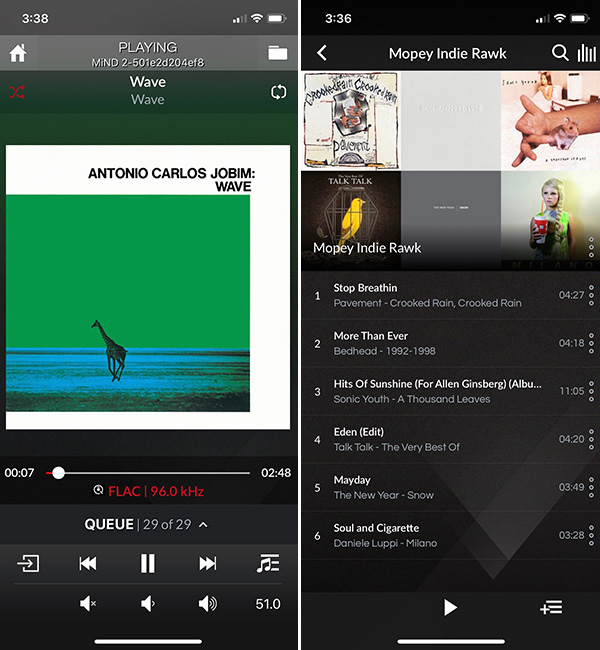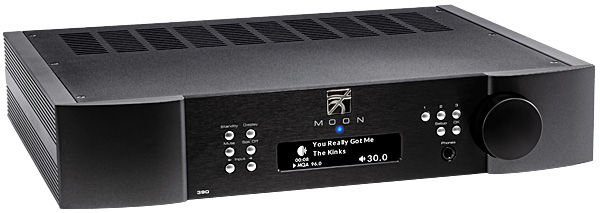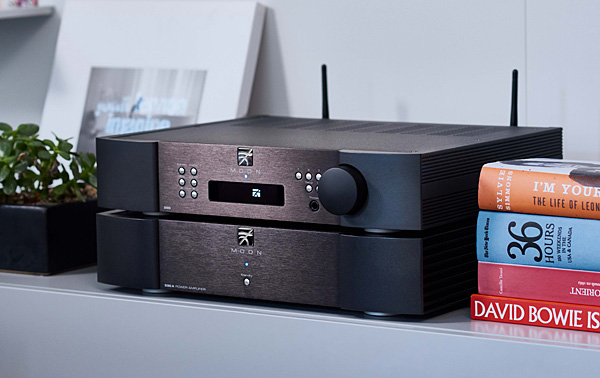Subscribing to both Tidal and Qobuz I find the MQA/Hi Res comparison a push so far. Some tracks sound virtually identical while others favor one or the other. Some MQA tracks sound muted and indistinct while some hi-res tracks are overly bright and harsh. YMMV.
Moon 390 Network Player/Preamplifier Review Page 2
Digital Performance
As a participant in the Qobuz U.S. Beta release program (let's hope that the service moves beyond beta to full U.S. availability by the time you're reading this), I was eager to experience high-res streaming via my Sublime+ account with the Moon 390. Not only that, but I was curious to compare the same high-res tracks streamed from Qobuz with their MQA "folded" counterparts on Tidal—something the 390's support for both services and its MQA decoding capability made possible.

Cueing up an MQA'd 24-bit/96kHz version of "I Love the Life I live" from Van Morrison's recent album The Prophet Speaks on Tidal, I heard clean separation and distinct sense of air between vocals, organ, saxophone, drums, and guitar in the bluesy, lounge-y track. Transients like an organ lead or a sudden snare drum thwack sounded crisp and dynamic without being in the least bit harsh. When I switched over to listening a 24-bit/96kHz FLAC stream of the same track on Qobuz, the sound was equally clear, dynamic and compelling. Like they say, six of one, a half-dozen of the other.
Sticking for the moment with Qobuz, I next streamed a 24-bit/96kHz FLAC of Radiohead's "Exit Music (For a Film)" from OK Computer. Here again, the clarity of the Moon 390's delivery, and its ability to separate and define layers in the sonic mix, stood out. Thom Yorke's voice loomed hugely in the soundstage, while the acoustic guitar came across as impeccably clean. When a mellotron-like synthesizer eventually joined in, its sound was appropriately lush and the presentation seemed to extend well beyond the physical confines of the speakers and the room itself.

While high-res audio is a selling point of the Moon 390, it didn't exactly need to be fed high-res audio to sound great. Listening to a 16-bit/44.1kHz FLAC stream of "Woodstock" by jazz supergroup Hudson, John Medeski's acoustic piano solo had a solid, almost meaty, presence, while Larry Grenadier's standup bass sounded sinewy and clean. The cymbals from drummer Jack DeJohnette's kit also had a 3D-like quality that made them float realistically in space.
I wrapped up my assessment of the Moon 390's digital chops by comparing the performance of its built-in DAC with the Pioneer universal disc player's using a handful of reference CDs. In each case, the sound delivered by the 390's DAC was more precise, layered, and clean. The performance of the Pioneer's DAC, in comparison, was consistently more recessed and less engaging.
Analog Performance
One product category Simaudio is known for is phono stages, and the features offered by the Moon 360's built-in one are the same as what you'd get with the company's Moon 110LP v2 ($399). Pulling out some LPs from my collection, I was surprised by the clean and dynamic sound I was getting. In some ways, it was consistent with what I experienced during digital playback.
Conclusion

Simaudio's Moon 390 is about as full-featured a stereo preamplifier as you'll find on the current hi-fi scene. Want to stream high-res audio tracks from Tidal and Qobuz? How about playing vinyl or other analog sources and then streaming the signal to multiple zones? Or perhaps you want a high-end stereo preamp that offers HDMI switching, including HDMI-ARC to stream sound from Netflix when watching TV? The 390 will do all of that and more. But what impressed me most about Simaudio's preamp was its performance—from streamed high-res tracks to standout discs from my LP collection, the 390 made listening an absolute pleasure. Yes, in this case high-end performance comes at a fairly high-end price, but the abundance of features offered up by the Moon 390 make it well worth consideration.
- Log in or register to post comments


When one sets aside its network streaming and multiroom features, the tree removal christchurch 390 seems and feels like a conventional high-end stereo preamp.




































































